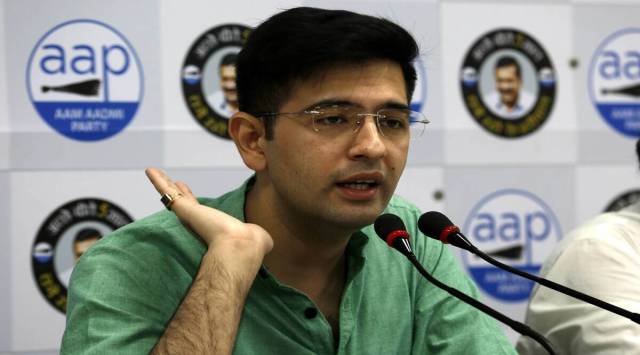- India
- International
DJB accuses Haryana of ‘criminal negligence’ for reducing Delhi’s water supply, dumping waste into Yamuna
Speaking at the Delhi Secretariat, Delhi Jal Board vice chairperson Raghav Chadha said Haryana was “wilfully violating the right to life” of people in Delhi by not releasing the agreed amount of water in the river and dumping waste into it.
 Chadha claimed there were no central police force personnel present at these places and there was no security observation of strongrooms through CCTV cameras. (Express Photo By Amit Mehra/File)
Chadha claimed there were no central police force personnel present at these places and there was no security observation of strongrooms through CCTV cameras. (Express Photo By Amit Mehra/File)Delhi Jal Board vice chairperson Raghav Chadha Tuesday accused the Haryana government of “criminal negligence” for reducing Delhi’s potable water supply through the Yamuna and releasing “untreatable” amount of waste in the river.
Speaking at the Delhi Secretariat, Chadha said Haryana was “wilfully violating the right to life” of people in Delhi by not releasing the agreed amount of water in the river and dumping waste into it that has shot up ammonia levels to a record high of 7.36 ppm.
He said water supply in the national capital will be impacted because of this Wednesday onwards, in areas within Central, South, North and West Delhi, including the New Delhi Municipal Council area which houses the Parliament and the Central Secretariat.
“The Haryana government is behaving in a reckless manner and is not honouring their agreements… This is criminal negligence on part of the Haryana government and to some extent they are wilfully violating the right to life of 22 million citizens of Delhi,” Chadha said.
He said the DJB has written several letters over the last 15 days to authorities in the neighbouring state, and that pollution in the river has been increasing steadily over the past two weeks.

“We were until now diluting this polluted water in the river through clear water received from Haryana through other channels. However, now the ammonia level has crossed the limit of treatment in addition to a reduction of water level in the river,” Chadha said.
At the Wazirabad pond area, from where Yamuna water is picked for treatment by various water treatment plants, the water level has reduced to 670 ft from the normal required level of 674 ft, Chadha said.
The current ammonia level is also significantly higher than DJB’s treatment capacity of 1ppm, and also against the safe limit of 0.5 ppm. Ammonia has shot up frequently in the river over the last two years and last time it reached 7 ppm was in December 2020.
Three water treatment plants of the DJB — Wazirabad, Chandrawal and Okhla — have at present reduced their treatment capacity by 35 to 40 per cent, Chadha said, which will impact supply to the city.
Delhi’s main potable water sources are the Yamuna, Ganga and Ravi-Beas rivers. Uttar Pradesh supplies about 240 million gallons per day (MDG) of Ganga water to Delhi through the Upper Ganga Canal.
About 550 MGD of water is supplied by Haryana through the Yamuna, and from the Ravi-Beas water it receives through the Bhakra Beas Management Board (BBMB).
An additional 120 MGD is extracted from underground aquifers and through recycling water that gets lost in the filtration process.
Chadha said DJB helplines would remain functional and supply through water tankers will be made available to customers facing shortage.
Supply is to be impacted in areas including, Timarpur, Jhandewalan, Karol Bagh, Sarojini Nagar, Lodhi Colony, Defence Colony, Model Town, Shalimar Bagh, Kalkaji, Tughlakabad and others.
Devender Singh, Haryana’s additional chief secretary of Irrigation and Water Resources Department, told The Indian Express that Chadha’s comments are “inaccurate and irresponsible.”
He said, “Water supplied to Delhi from Haryana comes from two main sources: the Bhakra reservoir — which gets water from the Ravi, Beas and Sutlej rivers — and from the Yamuna river. Because of less snow melting, presently there is about 20-25% shortage in the water received from the Bhakra reservoir and 50% shortage in the water received from the Yamuna river.”
Singh added, “This is causing a shortage in drinking water supply in Haryana and we have been getting complaints everyday that we are not supplying the adequate amount.”
He said as per Haryana’s agreement with Delhi and in compliance with various Supreme Court orders, about 1050 cusecs of water is supplied to Delhi everyday through the Munak canal, which comes down to about 940 cusecs by the time it reaches Delhi owing to losses.
“This (940 cusecs) is considered an acceptable amount and goes even above what the Supreme Court has directed. So despite such severe shortage in water availability, we are ensuring that Delhi receives good water supply and instead of expressing gratitude, these inaccurate allegations are being made against us.”
Singh also referred to an inspection done by the Central Pollution Control Board (CPCB) in January this year, which, according to him, found that ammonia levels increased between Palla and Wazirabad in Delhi, which indicates illegal waste discharge in the river in this stretch.
In two letters written to DJB CEO Nikhil Kumar in March, Singh pointed to these issues about water supply and ammonia and stated that: “dropping of pond level is only because of internal mismanagement of canal water by DJB.”
The letter also states that another reason for increase in ammonia levels, as indicated by CPCB inspection, is due to sediment deposited at the Wazirabad pond.
Apr 26: Latest News
- 01
- 02
- 03
- 04
- 05































